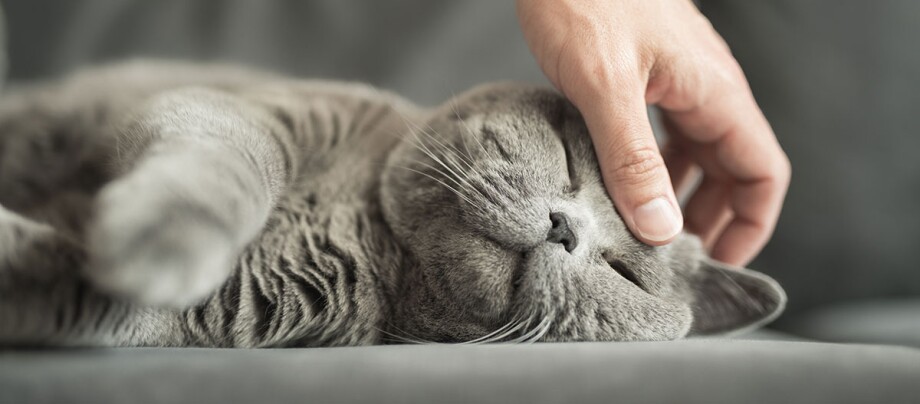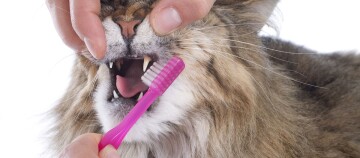How to Pet a Cat Right – Not Every Tiger Is a Cuddly House Mate
02.01.2024 - Reading time: 5 minutes

When a cat comes up to a person and demands to be stroked, it is enriching for both sides: the cat shows you its affection and you benefit from the relaxing effect that the touch of a (possibly purring) cat brings. However, stroking a cat is different from stroking a dog, for example. In fact, you should be aware of a few things when caressing your house cat. Read more about comfort zones and taboo areas here.
Why should you stroke a cat?
From a human perspective, there are a number of positive effects that come with stroking animals: as several studies have shown, touching the warm soft fur lowers the blood pressure and can even strengthen the immune system. Furthermore, stroking animals releases the “cuddle hormone” oxytocin, which, among other things, triggers feelings of happiness.
On the subject of hormones: cats are apparently able to sense hormonal changes in pregnant women, which leads some animals to show an increased need for cuddling. Petting a cat during pregnancy may be an even more intense experience, but make sure you wash your hands carefully afterwards and under no circumstances should you touch a stray or unknown cat.
Cats react in a very special way to being lovingly stroked, for example, when they in turn begin to purr comfortingly, snuggle up or otherwise give positive feedback. But beware: of all things, purring can be misleading, because cats also make this peculiar sound when they are in pain or under stress. So always consider the overall situation.
For stroking to be a pleasant experience for both humans and animals, there are a few rules you should follow. The most important is never to force physical contact on the cat. Wait for the cat to approach you – and interpret the signals it sends correctly.
Back, chin or flank: Where should I stroke my cat?
The parts of the body where a cat likes to be stroked are highly individual. Some cats love to be stroked on the rump or chest; others are ticklish and will only let you touch a few parts of their body, if any. Particularly sensitive areas are the paws and the cat’s belly – more on this below.
Tolerance among cats also differs when it comes to other “stroking zones”:
- Head: If you stroke the cat’s head and it follows your movements, perhaps even stretching out certain parts like the chin, it means it likes to be stroked. The area between the eye and the ear is a favourite spot for many cats.
- Neck: Stroking or scratching the throat or neck area is also well received by many cats.
- Ears: Some house cats like a – gentle – massage behind the ears.
- Back: Many cats do not like to be touched on the lower back or at the base of the tail, while others clearly enjoy being gently patted on this part of their body.
You will therefore have to find out for yourself which parts of the body where each cat likes to be stroked. You should also test how intensively to stroke your cat and the ideal rhythm. Be guided by the body language signals that the cat sends out to indicate whether it is comfortable being stroked. A cat that is relaxed and in the mood to be stroked will stretch out, seek physical contact and snuggle up. Some cats make sounds similar to a sigh, close their eyes or start to “paw”.
If the cat does not like being stroked, it will remain unimpressed and passive (as an tolerant animal) or defiantly turn away. It will become more explicit if it actively withdraws and walks away, snarls disagreeably or attacks your hand aggressively. Displeasure can also be seen in the way the cat holds its tail: If the tip of the tail starts to twitch or even the whole tail starts to whip, it is better to stop stroking it.
Under no circumstances should you hold a cat while petting it or stroke it against the direction of fur growth. Cats do not like to have their fur “ruffled”.
Some cats do not want to be stroked – not every tiger is a cuddly house mate. Be respectful if the animal simply isn’t fond of being touched and shows affection in other ways.
Why do cats bite when being stroked?
If the cat paws at you or bites your hand while you are stroking it, this can have several reasons:
- Defence: The cat does not want to be touched and rejects the stroking human hand. This is the animal’s way of telling you that the stroking is intrusive, annoying or painful. It may be that the animal has something else on its mind or that you have touched a spot where something is hurting.
- Reflexes: You may have simply hit a ticklish spot while stroking the cat or startled it with unexpected contact. In such cases, a bite or paw stroke can also be a reflex action.
- Overstimulation: If you have been stroking the same spot for too long, this can also provoke resistance. It is even possible for cats to become electrostatically “charged”.
In any case, it is advisable to stop stroking immediately if the cat bites you.
Is it okay to stroke a cat's belly?
A cat’s belly is one of the most vulnerable body parts. Even though cats do occasionally seem to show off this part of their body, interpreting this as an invitation to stroke their belly is a serious misunderstanding. It may be possible to scratch a cat’s belly if the animal is very relaxed, but it is more likely for the cat to perceive this as invasive and to fight it off – as described above, with paws and teeth.
If you know your cat’s individual preferences and are attentive to its body signals, there is nothing to prevent you from caressing it lovingly.


